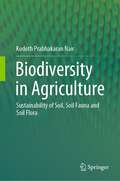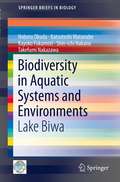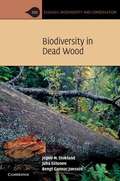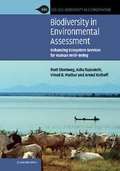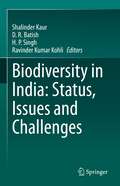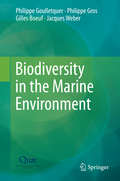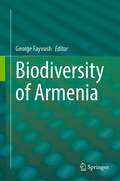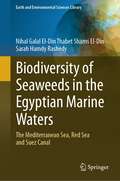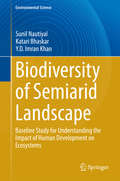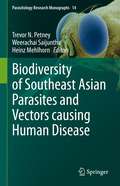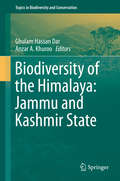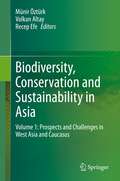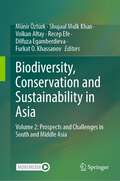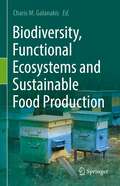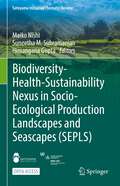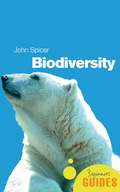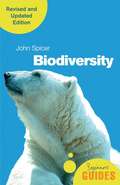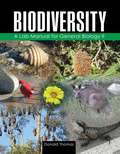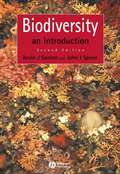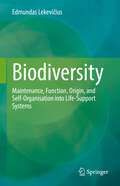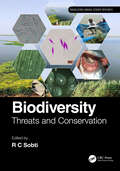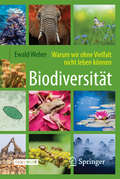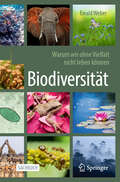- Table View
- List View
Biodiversity in Agriculture: Sustainability of Soil, Soil Fauna and Soil Flora
by Kodoth Prabhakaran NairThis book begins with the principal subject of biodiversity in agriculture. The onslaught of highly soil extractive chemical farming, euphemistically called the “green revolution”, has taken a heavy toll on soil biodiversity, hence, soil sustenance. Agrobiodiversity is a key resource for humanity. All of the food requirements humanity depends on are met by agrobiodiversity. Similarly, fodder fiber, firewood, and many other basic needs of humankind are also met by agrobiodiversity. The book puts forward ideas on how we are to develop a sustainable future, to provide a healthy and thriving environment for humanity by protecting, conserving, and augmenting agrobiodiversity.The pedosphere, the outermost layer of the Earth, composed of soil and subject to soil formation processes, is an integral component of biosphere, lying on the interface of the atmosphere, hydrosphere, and lithosphere and a lot more complex in its physicochemical and biological characteristics and functioning and quite distinguishable from that of the above soil-surface terrestrial and aquatic ecosystems. The biotic component of the pedosphere comprises a rich biodiversity of living species, dominated by microorganisms. This book considers and discusses the influences of soil formation processes.This book will be of interest to those engaged in researching biodiversity, agriculture, and crop science.
Biodiversity in Aquatic Systems and Environments: Lake Biwa (SpringerBriefs in Biology)
by Noboru Okuda Katsutoshi Watanabe Kayoko Fukumori Shin-Ichi Nakano Takefumi NakazawaThis book presents the latest topics in ecological and evolutionary research on aquatic biodiversity from bacteria to fishes, with special reference to Lake Biwa, an ancient lake in western Japan. With a geological history of 4 million years, Lake Biwa is the third oldest lake in the world. It is considered a biodiversity hotspot, where 1,769 aquatic species including 61 endemics are recorded, providing a rare opportunity to study the evolutionary diversification of aquatic biota and its ecological consequences. The first chapter introduces the evolutionary history of biodiversity, especially of fish in this lake. In the second chapter, some examples of trophic polymorphism in fish are described. Fish are keystone predators in lake ecosystems, and they can be a major driver for altering biological communities through their top-down trophic cascading effects. An excellent laboratory experiment is presented, demonstrating that functional diversity of fish feeding morphology alters food web properties of plankton prey communities. The third chapter focuses on aquatic microbes, whose abundance and diversity may also be influenced by the diversity of fish through top-down trophic cascades. Aquatic microbes can have a strong impact on ecosystem functioning in lakes, and in this chapter, the latest molecular techniques used to examine genetic and functional diversity of microbial communities are introduced. The final chapter presents theoretical frameworks for predicting how biodiversity has the potential to control the incidence and intensity of human-induced regime shifts. While respecting the precious nature of biodiversity in lakes, it is essential to be aware that modern human activities have brought a crisis of biodiversity loss in lakes worldwide. Throughout this book, readers will learn why biodiversity must be conserved at all levels, from genes to ecosystems.
Biodiversity in Dead Wood
by Jogeir N. Stokland Juha Siitonen Bengt Gunnar JonssonFossils document the existence of trees and wood-associated organisms from almost 400 million years ago, and today there are between 400,000 and 1 million wood-inhabiting species in the world. This is the first book to synthesise the natural history and conservation needs of wood-inhabiting organisms. Presenting a thorough introduction to biodiversity in decaying wood, the book studies the rich diversity of fungi, insects and vertebrates that depend upon dead wood. It describes the functional diversity of these organisms and their specific habitat requirements in terms of host trees, decay phases, tree dimensions, microhabitats and the surrounding environment. Recognising the threats posed by timber extraction and forest management, the authors also present management options for protecting and maintaining the diversity of these species in forests as well as in agricultural landscapes and urban parks.
Biodiversity in Environmental Assessment
by Roel Slootweg Asha Rajvanshi Vinod B. Mathur Arend KolhoffHuman induced development activities are introduced with insufficient attention to their consequences for our living environment, even in cases where environmental assessments have been carried out. This apparent lack of attention to biodiversity in environmental assessment is rooted in the difficulties we have in adequately addressing biodiversity within the scope, time frame and budget allocated for assessments. This book provides a conceptual background and practical approaches to overcome these difficulties. It integrates the objectives of the Convention on Biological Diversity, its ecosystem approach, and the conceptual framework of the Millennium Ecosystem Assessment into a comprehensive approach to biodiversity in environmental assessment. It highlights the need to consider the value of biodiversity based on its use by each stakeholder, addresses the importance of both social and economic development to reach the Millennium Development Goals, and provides insights into ways to balance present and future needs.
Biodiversity in India: Status, Issues and Challenges
by Shalinder Kaur D. R. Batish H. P. Singh Ravinder Kumar KohliThis contributed book is based on the current status of biodiversity in India, issues and challenges faced by the authorities involved in conservation efforts, and the imperative role of various direct and indirect stakeholders in biodiversity conservation. The book discusses the current status of different forms of biodiversity in India, challenges faced by stakeholders, issues and reasons for biodiversity losses, and efforts by government through various laws, policies, and programs in a concise and comprehensive manner throughout its many chapters. In this way, readers can access diverse information on Indian biodiversity through this book. It is compiled by leading experts in the field of conservation. In 18 chapters, it covers biodiversity of both fauna and flora, on land and in aquatic ecosystems, legal and policy aspects, as well as innovative conservation tool and techniques. It is useful for undergraduates and graduate students and also educates policy planners, bureaucrats, foresters, and researchers in India and abroad.
Biodiversity in the Marine Environment
by Philippe Goulletquer Philippe Gros Gilles Boeuf Jacques WeberThe oceans cover over 70% of our planet. They are host to a biodiversity of tremendous wealth. Its preservation is now a global priority featuring in several international conventions and a confirmed objective of European policies and national strategies. Understanding the dynamics and the uses of the marine biodiversity is a genuine scientific challenge. Fourteen international experts have got together and identified five priority research themes to address the problem, based on analysing the state of knowledge.
Biodiversity of Armenia
by George FayvushArmenia is a small landlocked mountainous country located in the Southern Caucasus. It is a typical mountainous country, having its lowest point of 375m above sea level and culminating at 4095m with an average altitude of 1850m, where the landscapes and ecosystems form a complex multi-functional system. In general, the ecosystems of Armenia are characterized by a number of peculiarities, which all together contribute to formation of rich and unique biodiversity. On the small territory of Armenia (less than 30 thousand km2) there are about 3800 species of vascular plants (about a half of the whole Caucasian flora), 428 species of soil and water algae, 399 species of mosses, 4207 species of fungi, 464 species of lichens, 549 species of vertebrates and about 17200 species of invertebrates. The biodiversity of Armenia is notable for high endemism: about 500 species of fauna (about 3% of the fauna) and 147 species of flora (3.8% of total flora) are considered endemics. Such a high level of endemism is typical only for some of the large islands. Due to the huge variety of climates (from dry subtropics to cold alpine) and soil conditions all the main Caucasian ecosystems (besides humid subtropics) are represented in Armenia – deserts and semi-deserts, steppes, meadow-steppes, forests and open woodlands, sub-alpine and alpine vegetation as well as intrazonal ecosystems. Therefore Armenia is a biodiversity hotspot both within the Caucasian ecoregion and around the globe. This book compiles, summarizes and analyzes data on flora, fauna and mycobiota of Armenia, with a special focus on the impact of forecasted climate change on biodiversity and ecosystems of the region.
Biodiversity of Seaweeds in the Egyptian Marine Waters: The Mediterranean Sea, Red Sea and Suez Canal (Earth and Environmental Sciences Library)
by Nihal Galal El-Din Thabet Shams El-Din Sarah Hamdy RashedyThe Arab Republic of Egypt enjoys a vital strategic location. Its northern border is the Mediterranean Sea, and its eastern border is the Red Sea, which give it a special significance from the bio-diversity point of view as a coastal zone, and as a sensitively diversified ecosystem. The shoreline of the Arab Republic of Egypt is about 3,000 km long. It is about 1,150 km long on the Mediterranean and about 1,850 km long on the Red Sea, which are connected by the Suez Canal, which is about 193.30 km in length. The three water masses are different ecologically and are experiencing wide range of pressures due to, eutrophication, coastal development, aquaculture and climate change. These conditions resulted in several species of seaweeds that adapt to these pressures and expand their living boundaries while others may fade away. Accordingly, the study of seaweeds biodiversity in the Egyptian marine waters is of great concern globally and constitutes an important element of global change research. The present book entitled Biodiversity of Seaweeds in the Egyptian Marine Waters summarizes our current understanding of the biodiversity of seaweeds in the Egyptian marine waters. It is a timely publication based wholly on primary data which were collected through extensive field studies conducted over the years covering the marine Egyptian waters and culminate the efforts of the Egyptian phycologists. The book contains high-quality images of some species in their existing habitats. This book gains critical importance from the fact that the Egyptian marine environment is witnessing rapid development, which will no doubt have a bearing on the coastal environment – and the baseline data on seaweed biodiversity would be useful to understand changes that may arise from physical changes in the environment as also pollution load and climate change.
Biodiversity of Semiarid Landscape: Baseline Study for Understanding the Impact of Human Development on Ecosystems (Environmental Science and Engineering)
by Sunil Nautiyal Katari Bhaskar Y.D. Imran KhanThis study presents authentic data compiled from field experiments and investigations, and provides a point of reference for any future changes associated with anthropogenic activity in semiarid ecosystems. Three years of continuous and rigorous empirical research on biodiversity (from phytoplankton to higher plants and from zooplankton to higher animals - all flora and fauna) in India's semiarid region have culminated in this work. Though there are many studies available on issues related to biodiversity, the majority cover either specific groups of plants or groups of animals; with the exception of this book, studies that include all flora and fauna including the phyto- and zooplanktons in a given ecosystem are not readily available. Further, the book focuses on an extremely important topic, firstly because semiarid landscapes are highly vulnerable to climate change, and secondly because other developmental activities will be undertaken in the region in an effort to meet its energy requirements. As such, the results of the current study will provide a standard protocol for subsequent monitoring and mapping of biodiversity for conservation and management. The book explores, quantifies and surveys plant and animal species from aquatic and terrestrial ecosystems, assessing and quantitatively analyzing the diversity indices of different vegetation strata. Further, it investigates the conservation status of each species (flora and fauna) in keeping with IUCN categories. The study also examines landscape dynamics using RS and GIS for vegetation analysis, and discusses traditional ecological knowledge related to the use, conservation and management of biodiversity. As such, it offers a unique and valuable resource not only for researchers from the environmental/ecological sciences but also for conservationists and policymakers.
Biodiversity of Southeast Asian Parasites and Vectors causing Human Disease (Parasitology Research Monographs #14)
by Trevor N. Petney Heinz Mehlhorn Weerachai SaijunthaThis thematic collection focuses on key parasites and their vectors in Southeast Asia. Up-to-date essays invite readers to discover parasite and vector morphology, genetic diversity as well as dynamic parasite communities linked to human land-use and climate change. The authors shed light on transmission pathways and explore tick-borne diseases, intestinal protozoa, cestodes, nematodes and the multiplicity of cryptic trematode species. Particular attention is given to mosquito vectors in changing environments and the dynamic biodiversity of vertebrate hosts, including mammals, birds and fish.The richly illustrated chapters are completed by new approaches in diagnostic methods, treatment and prevention to protect humans and animals from tropical parasite infections. Not only parasitologists and experts in tropical medicine but also public health officials and travelers will find this volume highly informative.
Biodiversity of the Gulf of Guinea Oceanic Islands: Science and Conservation
by Luis M. P. Ceríaco Ricardo F. de Lima Martim Melo Rayna C. BellThis open access book presents a comprehensive synthesis of the biodiversity of the oceanic islands of the Gulf of Guinea, a biodiversity hotspot off the west coast of Central Africa. Written by experts, the book compiles data from a plethora of sources – archives, museums, bibliography, official reports and previously unpublished data – to provide readers with the most updated information about the biological richness of these islands and the conservation issues they face. The Gulf of Guinea Oceanic Islands (Príncipe, São Tomé and Annobón and surrounding islets) present extraordinary levels of endemism across different animal, fungi and plant groups. This very high endemism likely results from the long geological history of the islands and their proximity to the diversity-rich continent. Many researchers, students and conservationists from across the globe are interested in documenting biodiversity on the islands, understanding the evolutionary origins of this diversity, and mitigating the impacts of global change on this unique archipelago. This book aims to be a primer for a broad audience seeking baseline biodiversity information and to serve as a roadmap for future research efforts aiming to fill knowledge gaps in understanding and conserving the unparalleled biodiversity of the Gulf of Guinea islands.
Biodiversity of the Himalaya: Jammu and Kashmir State (Topics in Biodiversity and Conservation #18)
by Ghulam Hassan Dar Anzar A. KhurooThe Himalaya, a global biodiversity hotspot, sustains about one-fifth of the humankind. Nestled within the north-western mountain ranges of the Himalaya, the Jammu and Kashmir (J&K) State harbours more than half of the biodiversity found in the Indian Himalaya. The wide expanse of State, spread across the subtropical Jammu, through the temperate Kashmir valley, to the cold arid Ladakh, is typical representative of the extensive elevational and topographical diversity encountered in the entire Himalaya.This book, the most comprehensive and updated synthesis ever made available on biodiversity of the J&K State, is a valuable addition to the biodiversity literature with global and regional relevance. The book, arranged into 7 parts, comprises of 42 chapters contributed by 87 researchers, each of whom is an expert in his/her own field of research. The precious baseline data contained in the book would form the foundation for assessing current status of knowledge about the bioresources, identify the knowledge gaps, and help prioritization of conservation strategies to steer the sustainable use of biodiversity in this Himalayan region. Given the breadth of topics covered under the banner of biodiversity in this book, it can surely serve as a model for documentation of biodiversity in other regions of the world. The book will be of immense value to all those who, directly or indirectly, have to deal with biodiversity, including students, teachers, researchers, naturalists, environmentalists, resource managers, planners, government agencies, NGOs and the general public at large.
Biodiversity, Biofuels, Agroforestry and Conservation Agriculture (Sustainable Agriculture Reviews #5)
by Eric LichtfouseSustainable agriculture is a rapidly growing field aiming at producing food and energy in a sustainable way for our children. This discipline addresses current issues such as climate change, increasing food and fuel prices, starvation, obesity, water pollution, soil erosion, fertility loss, pest control and biodiversity depletion. Novel solutions are proposed based on integrated knowledge from agronomy, soil science, molecular biology, chemistry, toxicology, ecology, economy, philosophy and social sciences. As actual society issues are now intertwined, sustainable agriculture will bring solutions to build a safer world. This book series analyzes current agricultural issues, and proposes alternative solutions, consequently helping all scientists, decision-makers, professors, farmers and politicians wishing to build safe agriculture, energy and food systems for future generations.
Biodiversity, Conservation and Sustainability in Asia: Volume 1: Prospects and Challenges in West Asia and Caucasus
by Münir Öztürk Recep Efe Volkan AltayOf the world’s seven continents, Asia is the largest. Its physical landscapes, political units, and ethnic groups are both wide-ranging and many. Southwest, South and Middle Asia are highly populated regions which, as a whole, cover an extremely large area of varied geography. In total, this domain is unique in its plant diversity and large vegetation zones with different communities and biomes. It is rich in endemics, with specific and intraspecific diversity of fruit trees and medicinal plants, including a number of rare, high value, species. At the same time, much of the land in the region is too dry or too rugged, with many geographical extremes. Overgrazing, oil and mineral extraction, and poaching are the major threats in the area.This two-volume project focuses on the dynamic biodiversity of the region with in-depth analysis on phytosociology, plants, animals and agroecology. There are also chapters that explore new applications as well as approaches to overcome problems associated with climate change. Much of the research and analysis are presented here for the first time. We believe this work is a valuable resource for professionals and researchers working in the fields of plant diversity and vegetation, animal diversity and animal populations, and geo-diversity and sustainable land use, among others.The first volume guides our readers to West Asia and the Caucasus region, while volume two focuses on issues unique to South and Middle Asia.
Biodiversity, Conservation and Sustainability in Asia: Volume 2: Prospects and Challenges in South and Middle Asia
by Dilfuza Egamberdieva Münir Öztürk Recep Efe Volkan Altay Shujaul Mulk Khan Furkat O. KhassanovOf the world’s seven continents, Asia is the largest. Its physical landscapes, political units, and ethnic groups are both wide-ranging and many. Southwest, South and Middle Asia are highly populated regions which, as a whole, cover an extremely large area of varied geography. In total, this domain is unique in its plant diversity and large vegetation zones with different communities and biomes. It is rich in endemics, with specific and intraspecific diversity of fruit trees and medicinal plants, including a number of rare, high value, species. At the same time, much of the land in the region is too dry or too rugged, with many geographical extremes. Overgrazing, oil and mineral extraction, and poaching are the major threats in the area. This two-volume project focuses on the dynamic biodiversity of the region with in-depth analysis on phytosociology, plants, animals and agroecology. There are also chapters that explore new applications as well as approaches to overcome problems associated with climate change. Much of the research and analysis are presented here for the first time. We believe this work is a valuable resource for professionals and researchers working in the fields of plant diversity and vegetation, animal diversity and animal populations, and geo-diversity and sustainable land use, among others.The first volume guides our readers to West Asia and the Caucasus region, while volume two focuses on issues unique to South and Middle Asia.
Biodiversity, Functional Ecosystems and Sustainable Food Production
by Charis M. GalanakisIn recent decades, practices like the cultivation of a few high-yielding crop varieties on a large scale, the application of heavy machinery and continued mechanization of agriculture, the removal of natural habitats, and the application of pesticides and synthetics have resulted in the simplification of agro-ecosystems. This has enabled a substantial increase in food production but has at the same time transformed landscapes. Indeed, there is a concern that a decline in biodiversity has affected microbiome activities that support processes across soils, plants, animals, the marine environment, and humans. Although they have increased food production, the above practices cannot be considered sustainable in long-term applications. Biodiversity, Functional Ecosystems, and Sustainable Food Production explore ecosystems in terms of crop and animal production, pest and disease control, nutrient cycling, and soil fertility. Chapters range from agro-biodiversity to antimicrobial use in animal food production to microbiome applications for sustainable food systems and the impacts of environment-friendly unit operations on the functional properties of bee pollen. By examining such topics about each other, the text emphasizes how food production, ecosystem function, food quality, and consumer health are all interconnected.
Biodiversity-Health-Sustainability Nexus in Socio-Ecological Production Landscapes and Seascapes (Satoyama Initiative Thematic Review)
by Himangana Gupta Maiko Nishi Suneetha M. SubramanianThis is an open access book. It is a compilation of case studies that provide useful knowledge and lessons that derive from on-the-ground activities and contribute to policy recommendations, focusing on the interlinkages between biodiversity and multiple dimensions of health (e.g., physical, mental, and spiritual) in managing socio-ecological production landscapes and seascapes (SEPLS). This book provides insights on how SEPLS approaches can contribute to more sustainable management of natural resources, achieving global biodiversity and sustainable development goals, and good health for all. It is also expected to offer useful knowledge and information for an upcoming three-year thematic assessment of “the interlinkages among biodiversity, water, food, and health” (the so-called “nexus assessment”) by the Intergovernmental Science-Policy Platform on Biodiversity and Ecosystem Services (IPBES). The book begins with an introductory chapter followed by eleven case study chapters demonstrating the nexus between biodiversity, health, and sustainable development, and then a synthesis chapter clarifying the relevance of the case study findings to policy and academic discussions. It will be of interest to scholars, policymakers, and professionals in the field related to sustainable development.
Biodiversity: A Beginner's Guide (Beginner's Guides)
by John SpicerIn this steadfast and yet witty guide, biologist John Spicer examines biodiversity, giving the reader an insight into the myriad of organisms that surround us.
Biodiversity: A Beginner's Guide (revised and updated edition) (Beginner's Guides)
by John SpicerOur future is closely tied to that of the variety of life on Earth, and yet there is no greater threat to it than us. From population explosions and habitat destruction to climate change and mass extinctions, John Spicer explores the causes and consequences of our biodiversity crisis. In this revised and updated edition, he examines how grave the situation has become over the past decade and outlines what we must do now to protect and preserve not just nature&’s wonders but the essential services that biodiversity provides for us, seemingly for nothing.
Biodiversity: A Lab Manual For General Biology II
by Donald R. ThomasThis lab manual is intended to accompany the General Biology II course at Southwest Tennessee Community College. This course focuses on the evolution and diversity of living organisms with attention to comparative anatomy within the vertebrate animals. The manual contains instructions for hands-on examination of specimens with minimal repetition of content found in the recommended textbook (Biology. Solomon and Berg, current edition). This format is used with the motive of saving costs for the student and encouraging the use of the text and the instructor s assistance for explaining unfamiliar vocabulary. In addition to the illustrations in this manual, students may also find photographs and anatomical diagrams of the subjects on the internet as well as in the textbook"
Biodiversity: An Introduction
by Kevin J. Gaston John I. SpicerCLICK HERE TO DOWNLOAD ARTWORK This concise introductory text provides a complete overview of biodiversity - what it is, how it arose, its distribution, why it is important, human impact upon it, and what should be done to maintain it. Timely overview of the serious attempts made to quantify and describe biodiversity in a scientific way Acts as an easy entry point into the primary literature Provides real-world examples of key issues, including illustrations of major temporal and spatial patterns in biodiversity Designed primarily with undergraduate students and course lecturers in mind, it will also be of interest to anyone who requires an overview of, and entry to, the vast literature on these topics. All the figures included in the book are downloadable from the Blackwell Publishing website
Biodiversity: Maintenance, Function, Origin, and Self-Organisation into Life-Support Systems
by Edmundas LekevičiusSpecies are not functionally independent. From a long-term perspective, only ecosystem with a fully integrated nutrient cycle is alive. The lack of trophic autonomy should be considered one of the key factors that ensure and maintain biodiversity. The variability of abiotic conditions, both in space and in time, also creates a huge diversity of niches and subniches for genotypes and species. In addition, life maintains its essential variables (biomass and productivity) as stable as possible due to the diversity of structures (genes, macromolecules, metabolic pathways, genotypes, species, etc.): the structures that reach optima are multiplied and thus activated, while the functioning of those which lost their optima is suppressed. The facts and concepts presented in this monograph thus support the conclusions that (a) genotype and species diversity is supported by trophic specialisation (b) biodiversity helps to stabilise the functions (essential variables) of individuals, populations, and ecological communities (c) in evolution, the emergence of biodiversity is determined by heritable variation and the advantage of specialised (more effective) structures over non-specialised ones (d) biodiversity is characterised by its ability to increase itself and to organise itself into relatively consistent structures, which we call production pyramids and nutrient cycles. This book therefore provides an answer to the question "why the diversity of life is of such and such a nature".
Biodiversity: Threats and Conservation (Translating Animal Science Research)
by Rc SobtiThe term "biodiversity" or "biological diversity" describes the variety of living beings on Earth encompassing microorganisms, plants, animals, and ecosystems, such as coral reefs, forests, and deserts. In fact, it also represents a wealth of biological resources available to us. Today, instead of exploring and preserving its unmapped biodiversity, mankind has gone away from mother nature, conquering the domain through relentless exploitation. This has resulted in an ecological imbalance and thereby has posed serious threat to biodiversity. Declining biodiversity is, therefore, a concern for countless reasons. Biodiversity’s wealth of genetic information can be conserved by storing biological material from endangered species. Cell lines, gametes, and embryos are preserved so that in case a species becomes extinct or there is a need to increase the population of the species, then cloning and artificial reproductive techniques can be used to revive and reproduce the said species. The present volume discusses the biodiversity of specific animal groups, such as cnidarians and fish, as well as potential risks to and methods for conserving some of them. The following important aspects are addressed: 1. The importance of biodiversity in maintaining ecosystem balance for sustainability 2. The emerging role of biodiversity as a source of important materials, pharmaceuticals, food, and so on as such or through genetic manipulation to meet the contemporary and future challenges 3. The impact of environment degradation on biodiversity and conservation in a changing environment 4. Conventional and emerging biotechnological techniques to conserve biodiversity The book is intended for academics, scientists, and naturalists working in the fields of biology, biochemistry, biophysics, and biomedical sciences.
Biodiversität - Warum wir ohne Vielfalt nicht leben können
by Ewald WeberEine Einladung in die Biologie der Vielfalt Dieses Buch berichtet über ein ebenso spannendes wie aktuelles Thema an der Schnittstelle zwischen naturwissenschaftlicher Grundlagenforschung und globaler gesellschaftlicher Herausforderung: die Biodiversität. Drei Ebenen kommen hier zusammen: die Vielfalt der Arten in einem Lebensraum, die Vielfalt der Ökosysteme und Lebensräume selbst und die Vielfalt der Gene in den Lebewesen. Der Autor, Biologe und selbst in der Biodiversitätsforschung tätig, nimmt Sie mit auf eine aufregende Entdeckungsreise durch diese mannigfach vernetzte Welt. In leicht verständlicher Sprache und mit vielen anschaulichen Beispielen erklärt er Zusammenhänge und Hintergründe. Wie ist Biodiversität eigentlich definiert, und mit welchen Techniken wird sie erfasst? Wie ist die immense Artenvielfalt auf der Erde entstanden, und wie entwickelt sie sich weiter? Welchen Nutzen hat die Biodiversität auf den verschiedenen Ebenen? In welchem Maße ist die Vielfalt der Arten und Lebensräume heute bedroht, und wie kann man diesem Trend entgegenwirken? Solche und ähnliche Fragen beantwortet dieses Buch, in dessen breitem Themenbogen sich die Vielfalt seines Gegenstands wiederspiegelt. Tauchen Sie ein in die faszinierende Welt der Biodiversität! Der AutorEwald Weber ist Biologe und Sachbuchautor. Er lehrt und forscht an der Universität Potsdam mit Schwerpunkt Biodiversität. Sein Anliegen als Autor ist das Vermitteln von wissenschaftlichen Zusammenhängen und von Naturgeschichte im weitesten Sinn.
Biodiversität - Warum wir ohne Vielfalt nicht leben können
by Ewald WeberDieses Buch berichtet über ein ebenso spannendes wie aktuelles Thema an der Schnittstelle zwischen naturwissenschaftlicher Grundlagenforschung und globaler gesellschaftlicher Herausforderung: die Biodiversität. Drei Ebenen kommen hier zusammen: die Vielfalt der Arten in einem Lebensraum, die Vielfalt der Ökosysteme und Lebensräume selbst und die Vielfalt der Gene in den Lebewesen. Der Autor ist Biologe und war selbst in der Biodiversitätsforschung tätig. Er nimmt Sie mit auf eine aufregende Entdeckungsreise durch diese mannigfach vernetzte Welt. In leicht verständlicher Sprache und mit vielen anschaulichen Beispielen erklärt er komplexe Zusammenhänge und Hintergründe. Wie ist Biodiversität definiert, und mit welchen Techniken wird sie erfasst? Wie ist die immense Artenvielfalt auf der Erde entstanden, und wie entwickelt sie sich weiter? Welchen Nutzen hat die Biodiversität auf den verschiedenen Ebenen? In welchem Maße ist die Vielfalt der Arten und Lebensräume heute bedroht, und wie kann man diesem Trend entgegenwirken? Solche und ähnliche Fragen beantwortet dieses Buch, in dessen breitem Themenbogen sich die Vielfalt seines Gegenstands widerspiegelt. Die 2. Auflage des Buches berücksichtigt dabei neuste Erkenntnisse aus der Forschung und neue Entwicklungen zum Rückgang der biologischen Vielfalt. Aber auch von den zahlreichen Bemühungen, dem Verlust entgegenzuwirken, ist die Rede. Die Erfolgsgeschichten des Naturschutzes geben Anlass zur Hoffnung. Biodiversität ist faszinierend und wertvoll – tauchen Sie ein in die faszinierende Welt der biologischen Vielfalt!
